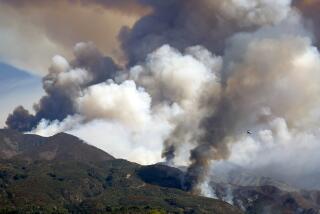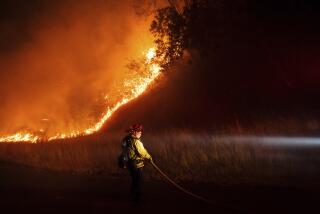Firefighters Go on Red Alert With Dry Winds of Fall
- Share via
TUSTIN — For several days recently, Fire Station 43 has had five bright red fire engines parked at its front curb, instead of the usual single engine. Its employee lounge has been host to 17 firefighters instead of the familiar three. And the days have been filled with the bustling footsteps of hulking figures in heavy helmets dragging endless hoses to and fro.
They have been practicing for an event that they hope will never arrive. For this is September in Orange County, when the Santa Ana winds begin stirring concerns in the hearts of firefighters as they conduct their annual ritual.
“We’re just getting into the most dangerous period of the fire season,” said Dan Young, a spokesman for the Orange County Fire Authority. “This is when little fires become big ones.”
Most of Southern California’s major wildfires have occurred in the fall, according to Young. The devastating Laguna Beach fire of 1993 broke out in October, followed closely by the Malibu fire. And in Orange County, he said, virtually every major brush fire since the 1940s has happened in October and November.
Conditions this year are especially conducive to runaway burns, Young said. An unusually wet winter produced an excessive growth of vegetation, which then became crisp and brittle during one of the driest summers on record. Add to that the fast dry Santa Ana winds that usually kick up at this time of year, and you have a volatile mix of conditions.
“A fire can start any time,” Young said, “and we are usually able to catch it. When they’re driven by 40-m.p.h. Santa Ana winds, however, they can spread phenomenally. We have no greater chance of stopping a fire driven by a Santa Ana wind than of stopping an earthquake; the fire will burn until it runs out of fuel or until the wind stops.”
County firefighters are responding to the threat in the usual way, first by reacting quickly and aggressively to any fire reports that come their way.
“In February if someone called and said there was a car fire in Santiago Canyon,” Young said, “we would send an engine to put out the fire. Today, we would send six engines, two bulldozers, three water tenders, four hand crews and a helicopter. And if it were on state land, we would also launch two fixed-wing aircraft.”
Firefighters also are taking a proactive approach to the dangers by monitoring the fire-prone areas, in person and with machinery, before the first sparks ignite.
Using a variety of sources, fire officials daily keep a watch over and analyze such factors as air temperature, chaparral temperature, relative humidity and wind speed. The information comes from national weather reports, field observations and readings from two Remote Automatic Weather Stations, one in Fremont Canyon, the other in Bell Canyon.
When those factors combine to create especially hazardous conditions--with temperatures high, humidity low and the winds constant--fire trucks are dispatched to all corners of the county looking for trouble before it happens.
“Every fire station is on patrol looking for fires or activities that may start them,” Young said. Among the things being watched for, he said, are would-be arsonists in the process of doing their dirty work. “Investigators are out in the wild lands removing or arresting people before they can start fires,” he said. “Sometimes just the presence of the engines reminds people to act a little safer.”
On days when conditions are not at their worst, but still considered hazardous, he said, strike teams consisting of several engines and attending personnel are sent to outlying stations where they remain poised within easy access of highly volatile canyon areas.
So it happened that for several days this week, Tustin’s Fire Station 43--virtually within 20 minutes of any wilderness area in Orange County--found itself hosting a large group of visiting firefighters.
“Right now we’re looking at the beginning of the most critical period,” said Kevin Brame, a battalion chief and strike team leader. “From here we can quickly deploy. Being organized can really save time.”
It saved time on Wednesday when the strike team from Station 43 was sent out to battle a 10-acre blaze at nearby Trabuco Canyon. “The deployment was very effective,” Young said of the fire, which was contained within 40 minutes with no structural damage. “It looked like an army out there.”
Yet, no amount of preparation gives firefighters the upper hand during this fire season.
“Anybody who thinks we can stop them [fires] is not in touch with reality,” Young said. “We live in Southern California and we live with fires.”
The solution? “None of this will have any real value or effect if people don’t make their homes non-combustible,” Young said. “We’re not going to stop all these fires; we just need to learn how to survive them.”
(BEGIN TEXT OF INFOBOX / INFOGRAPHIC)
Burning Season
Orange County is particularly susceptible to fires this season because a wet winter followed by a very hot summer has left a cover of heavy, dry vegetation. Here are steps you can take to reduce the risk of your home being caught in a wildfire:
* Remove dead branches, leaves and needles from all plants.
* Plant trees, ornamental shrubbery and ground cover that are considered non-flammable.
* Use fireproof shake shingles.
* Space trees and shrubs at least 20 feet apart.
* Prune lower limbs of tall trees to within 6 feet of ground.
* Trim branches to at least 10 feet from chimney.
* Clean leaves and needles from roof, gutters.
* Cover chimney with half-inch steel mesh to prevent sparks spewing out and landing on roof.
Safety Zone
To reduce chances of a wildfire spreading onto your property, establish a 30-foot zone free of flammable vegetation. It also gives firefighters room to maneuver.
Hazardous Vegetation
The following are considered highly flammable. It is best to use these in isolated plantings:
* Juniper
* Cypress
* Eucalyptus
* Pampas grass
Dial 911
A large percentage of vegetation fires are the result of arson. Fire officials ask that any suspicious activity be reported immediately.
Cost of Flames
While the number of wildfires burning Orange County has remained relatively stable during the last five years, the acres burned and cost have varied greatly:
Fires
1990: 297
1991: 295
1992: 307
1993: 317
1994: 254
Acres Burned
1990: 15,557
1991: 220
1992: 320
1993: 22,917
1994: 1,919
Cost
1990: $801,317
1991: 836,000
1992: 12,160
1993: 528 million
1994: 31,845
Source: Orange County Fire Authority
Researched by JULIE SHEER and APRIL JACKSON / Los Angeles Times
More to Read
Sign up for Essential California
The most important California stories and recommendations in your inbox every morning.
You may occasionally receive promotional content from the Los Angeles Times.










